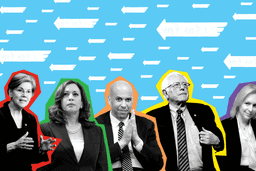The Democrats Abandon the White Working Class to Trump At Their Own Peril
The idea that the working class is a lost cause becomes a self-fulfilling prophecy for the Democratic Party.
Theo Anderson

Last year, two Princeton University scholars reported a startling development: a sharp rise in the mortality rate among middle-aged white people. The increase meant about 500,000 more deaths between 1999 and 2013 than if the mortality rate had continued to fall at the same rate as in years prior. The primary causes, the scholars noted, were drug use and suicide, along with alcoholism and related diseases. The spike in deaths was especially sharp among people with a high school degree or less.
Those findings were widely reported. They coincided with Donald Trump’s emergence as the star of the GOP primary race, and they helped to establish the narrative for this race. It was easy to connect the dots between the grim statistics and the rising popularity of Trump, a reality TV star who claims to speak for people who’ve been marginalized and dispossessed in America — in other words, the working class.
The problem? That simple storyline doesn’t withstand much scrutiny.
It’s true that Trump voters are overwhelmingly white and tend to have less formal education than Democratic voters. But they aren’t primarily “working class” if that’s defined by income. A senior economist with Gallup, Jonathan Rothwell, studied the data and found that, “if anything, more affluent Americans favor Trump, even among white non-Hispanics.” That analysis squares with median household income estimates of voters done by FiveThirtyEight, based on exit polling in the primary season. For Trump voters, it was $72,000. Among Hillary Clinton and Bernie Sanders voters, it was $61,000. The median household income for the states studied was $56,000.
Fear and loathing
The key to explaining support for Trump, Rothwell found, wasn’t income but anxiety. Trump supporters live in culturally and racially isolated areas and are afraid that they’ll soon live in a nation that’s no longer recognizable. “Support for Trump is highly elevated in areas with few college graduates,” Rothwell wrote, “far from the Mexican border, and in neighborhoods that stand out … for being white, segregated enclaves, with little exposure to blacks, Asians, and Hispanics.”
Trump claims, nonetheless, to be the “voice” of the marginalized, and media portraits of working class people who support him have bolstered that claim. The conservative intellectual Francis Fukuyama gave a pure distillation of the common wisdom in an interview with The Ezra Klein Show recently: “The Trump candidacy represents the forgotten white working class that has been underrepresented in American democracy over the past generation,” he said. “So they’re getting a voice.”
That’s wrong on two levels. It isn’t primarily the white working class that has propelled Trump’s rise. And his supporters are far from forgotten or ignored.
In truth, their power and their voice are far out of proportion to their numbers. Among the clearest and most destructive examples is the U.S. Senate. Consider that the nation’s five smallest states (by population) had about 3.5 million people as of 2015, while the five largest states had some 120 million people. Generally, the larger states are much more racially and ethnically diverse than the smaller states, which are overwhelmingly white. Yet the five smallest and five largest states have equal representation: 10 percent of the votes. In a Senate that’s closely divided, and in which use of the filibuster to paralyze the process has become routine, the over-representation of white people has far-reaching consequences.
That stark inequality brings into focus a deeper reality: The system has always tilted sharply in favor of the white people who make up Trump’s base. He’s not tapping into the frustrations of the white working class so much as stoking the fears of relatively affluent people who resist the cultural, religious and demographic changes that are happening in America, and are afraid of losing their place — their identity — in the emerging nation. For all his attempts to portray himself as an outsider, Trump is the ultimate establishment candidate. He is the voice, mainly, of people who’ve benefitted from the rigged system.
Still winnable
The misperception of Trump voters creates a fatalism about what can be done to relieve poverty and inequality in the United States, and about the possibility of building a stronger progressive, Democratic coalition. The idea that the working class is a lost cause becomes a self-fulfilling prophecy.
Democrats have lost much of the working class since the era of Ronald Reagan. But a substantial share hasn’t bought into Trump’s racism or the GOP’s anti-LGBT agenda, much less Republican prescriptions for building the economy. In Michigan — a key Midwestern state that’s been hit hard by deindustrialization — Barack Obama won 45 percent of the white working class vote in 2012. In the 2016 Michigan primary, Sanders won 23 percent of it. Together, he and Clinton won 40 percent of white working class votes, versus 27 percent for Trump and 58 percent for GOP candidates overall.
That isn’t a great showing for Democrats. But consider: Sanders got nearly as many white working-class votes as Trump. There’s no reason to think the Democratic Party couldn’t reach more of them with an agenda that, like the Sanders campaign, focuses on their needs and priorities. Affordable child care and college are obvious examples. Early childhood education is less obvious, but there is a mounting body of evidence about its benefits for children and its success in reducing inequality. Clinton, to her credit, has been one of its strong advocates.
Democrats have often been accused of romanticizing the white working class. Recently, author Thomas Frank has indicted the party for abandoning them. But neither claim is quite right. Mostly, Democrats have defended existing programs that benefit the working class without spending much energy to expand them, and without making the case for why it makes sense, morally and economically, to do so.
Trump has partially filled the vacuum left in our politics with his own idiosyncratic brand of populism. But much of the white working class has rejected his bigotry and false promises. The evidence suggests that their minds are open and their votes are winnable, if and when Democrats are serious about reaching out to them.








